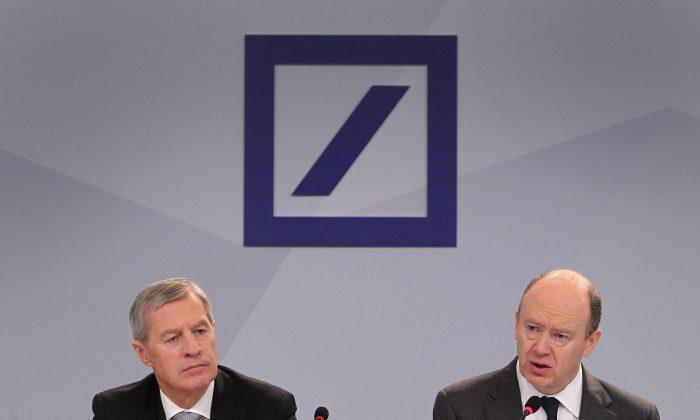Despite assurances by Deutsche Bank Co-CEO John Cryan that the bank is “rock solid,” historical precedents of bank failures and parallels to Deutsche’s situation today are scaring the markets.
In fact, the similarities between Germany’s largest bank and the likes of bankrupt Lehman Brothers, Bear Stearns, Fortis, and AIG are eerily familiar. Besides the fact that all of them were overleveraged and had little capital relative to their assets or derivative book, there are other commonalities that should give Deutsche Bank shareholders pause.
Needless to say, the stock is in free-fall. Down 31 percent this year, it is almost 90 percent off its 2007 all-time high of 117 euro. If you look up charts of the other big bankruptcies during the financial crisis, they look much the same before the equity value was eventually wiped off the charts completely.
There were also massive rallies, like on Feb. 10, when the stock jumped 7.5 percent. Lehman, Bear Stearns, AIG, and Fortis as well as many others rallied 10, 20, or even 30 percent in a single day or week. This is not a sign of strength, as the rallies mostly come on the back of rumors the company will be bailed out by the central bank or the government.
“Investors have completely lost their faith in the bank,” a top 10 shareholder in the company told Reuters.
Of course, the stock wouldn’t be dropping like a solid rock if the company didn’t report massive losses last January, $7.7 billion for 2015. Lehman reported a $3.9 billion loss in the last quarter they did report earnings in 2008, just before the company went bankrupt.
An insurance contract on Deutsche Bank’s senior secured debt is now more expensive than at any point during the financial crisis. Although it is not quite as expensive to insure against default than it was for AIG and Lehman during the financial crisis of 2008, Deutsche Bank is getting there.
Liquidity
And there is another, probably more important, point that the five companies have in common. Before the other four went bankrupt, they had to go public to defend their liquidity and capital position.
Take Belgian bank Fortis for example, which had to be bailed out by the Belgian government and French Bank BNP Paribas in late 2008: “Fortis firmly denies rumors currently in the market and confirms its earlier statements” the company said in September 2008. It also said there were no “problems about solvency and liquidity.” A week later the shares were worthless.
Sound familiar? “On Monday [Feb. 8], we took advantage of this strength to reassure the market of our capacity and commitment to pay coupons to investors,” the statement by John Cryan reads.
“I don’t trust Deutsche Bank. I don’t trust what they’re saying. And there’s reason why the banks are being sold all across the world ... because people are realizing once again that we don’t know what’s there [on bank balance sheets],” said financial market commentator David Stockman.
Deutsche also came out defending its liquidity position this week, much like Bear Stearns had done in early 2008, just before it went bankrupt.
Watch from 3:30 to hear what former Bear Stearns CEO Alan Schwartz had to say about the company’s liquidity situation before it went bankrupt.
“Bear Stearns … reported that it was in compliance with applicable rules with respect to capital and liquidity pools shortly before its failure, but the SEC and Bear Stearns did not anticipate that certain sources of liquidity could rapidly disappear,” it says in a GAO report.
“According to SEC officials, Bear Stearns’s failure was due to a run on liquidity, not capital. Shortly after Bear Stearns’s failure, the then SEC Chairman noted that Bear Stearns failed in part when many lenders, concerned that the firm would suffer greater losses in the future, stopped providing funding to the firm, even on a fully-secured basis with high quality assets provided as collateral.”
This is also known as a bank run. However, it’s not depositors who stage the run, it’s other banks who are already pulling their funding.
A Dubious Endorsement
Deutsche also shares some commonalities with bankrupt Greece, which German finance minister Wolfgang Schäuble claimed was fixed before. Now he says that he has “no concerns” over Deutsche Bank, a dubious endorsement.
Deutsche Bank is special in that it has already paid billions in fines and legal fees, something the other institutions and even Greece have managed to avoid before their demise. Billions more are set to follow, making raising new capital very difficult.
When it comes to bankruptcy, however, there are a few more steps that Deutsche has to complete if it is to join the likes of Lehman and AIG. Apart from raising new capital, regulators will most likely ban short-selling in its stocks. They did this for Fortis in 2008 to no avail.
After this step fails and the bank doesn’t manage to convince international peers it is worth funding, it will likely look for somebody to merge with, probably another German bank and with the help of government money.
If this doesn’t work, the German taxpayer will have to foot the bill to bail out a bank which by all counts is too big too fail.






Friends Read Free